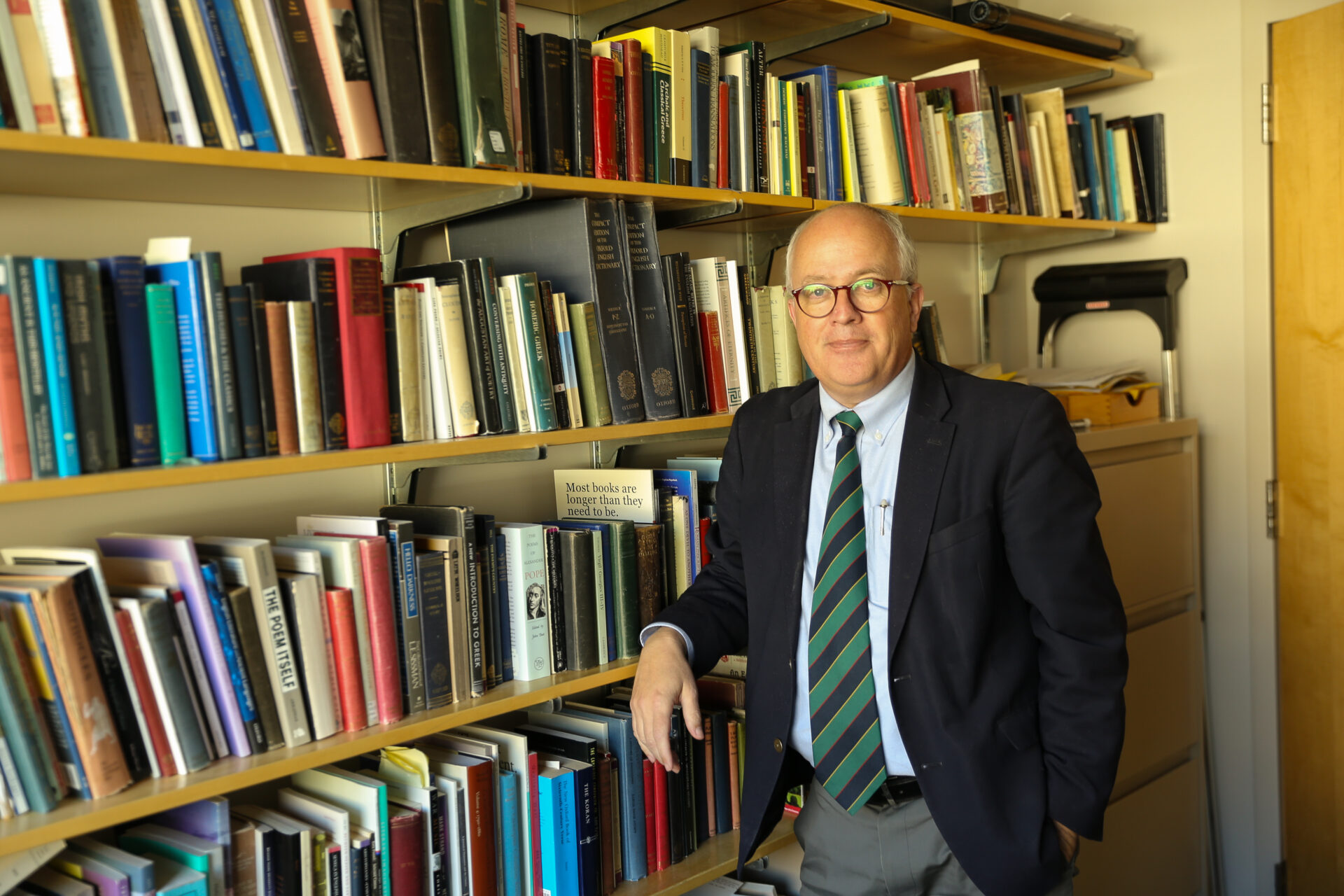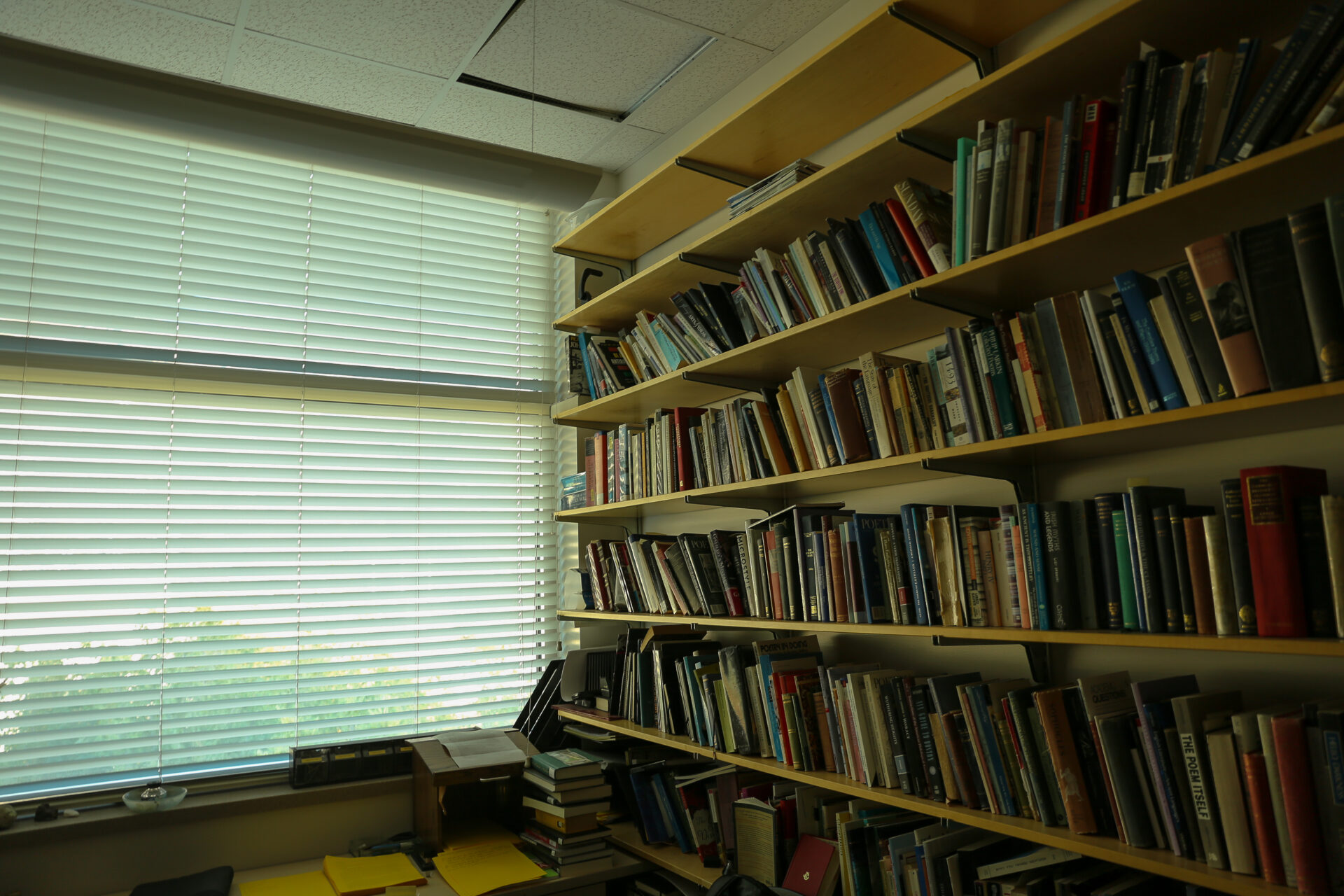
Professor John Talbot used the words “rude,” “arrogant” and “self-centered” when describing his former teenage self.
“I teased my teachers mercilessly. I made jokes in class and persecuted them … half of the faculty just adored me, and half the faculty hated me,” Talbot said. Yet Talbot has come a long way from his troublemaking teens.
Talbot, a BYU English professor, is an acclaimed poet and scholar with a doctorate in Greek and Latin from Boston University. While his accomplishments are vast, Talbot described his educational and professorial journey as the result of luck and pursuing his passions.
“My path was just a series of serendipities … all I was doing was just doing what I loved,” Talbot said.
Talbot grew up in the Salt Lake area and began consuming poetry and novels from a young age. He didn’t relate well to people his age, especially during his teenage years, and he spent a lot of time reading on his own or pestering teachers during school hours — when he bothered to attend class.

“As long as there were people talking that I could listen to, or as long as there were books around, I had more than I could possibly enjoy … I love humans. I love human voices. I love language. And then I found the most interesting concentration of those things in poems, more than anything else,” Talbot said.
Talbot claimed at home he was a picture-perfect child, always polite, well-spoken and never acting out or breaking curfew. He would crack open John Milton’s “Paradise Lost” or watch “Gilligan’s Island” on television, retiring to bed early. Yet he was, in his own words, “living a double life.” At school, young Talbot wreaked havoc, cutting classes and pulling pranks on his teachers.
One prank Talbot recalled was first conceived after having a conversation with Mrs. McGee, the school librarian. He described Mrs. McGee as having “a stern, angular face, cat’s eyeglasses with the chain in the back … beehive hairdo, great beefy forearms.” He asked the maximum amount of books he could check out, and she replied 15.
The following day, Talbot went to everyone in the school, enlisting them to check out the maximum 15 books throughout the next day. Starting at the crack of dawn, there was a steady succession of students checking out books. By the end of the day, the library shelves were “absolutely depleted,” Talbot said.
Talbot graduated high school and went on to study the classics, Ancient Greek and Latin at the University of Utah. Once he completed his undergraduate degree, he applied to several graduate schools to continue studying what he loved rather than being job-oriented. He chose Boston University because he greatly admired a few professors teaching there, he said.
While writing his dissertation and working on his first book of poetry, Talbot stumbled upon a remarkable opportunity to teach at Boston University’s brand-new high school program. This high school would not offer electives, but only focus on the base courses of science, math, English, history and a language of either Greek or Latin. He wrote to John Silver, president of Boston University at the time, proposing he teach the Greek and Latin program.
After a fortuitous run-in with Silver on campus, Talbot was told to ditch class, find a typewriter and write up his proposal for the Greek and Latin program. He heeded Silver’s advice, but when Talbot’s interview for the position rolled around, the headmaster of the high school instantly rejected him, saying they had received much more qualified applicants and he wouldn’t be considered.
Talbot immediately walked out of the interview. When news of this got back to Silver, he fired the headmaster and hired Talbot for the position. Talbot said he spent seven fulfilling years teaching at Boston University’s high school, which he described as “the best academic experience of my life.” He then received an invitation from BYU to join the English Department.
Talbot was not initially interested in the position at BYU. He loved his work at the high school, and he and his wife Sandy didn’t want to uproot their life in Massachusetts. Although it wasn’t initially something he wanted to do, Talbot knew deep down it was the right decision, and he hasn’t regretted it since.
“To be in the presence of young people like this and have a conversation like this doesn’t happen in other jobs. I mean, it’s just revivifying … It’s a pleasure to be able to write books about what you’re interested in,” Talbot said about his position at BYU.
Despite the hard work, pressure and intensity of being a professor, there’s nothing else he would rather be doing.
“It’s a rare, rare thing … But it’s so hard to get now. And for me, it was a series of happy accidents,” Talbot said.
Talbot said although he truly enjoys his work writing and analyzing poetry and teaching students, he recognizes how difficult and competitive the academic world has become. Talbot feels universities have become much more rushed and rigid, “outcome-oriented” and that there’s less space to experiment and explore.
A couple of students in Talbot’s poetry class have described his course as much more relaxed, providing space to explore what Talbot wants to see more of in higher education.
Elizabeth Anderson, a senior studying English from Anchorage, Alaska, is currently in Talbot’s poetry course. Anderson said Talbot’s class is very “free-form,” and focuses on students understanding poetry and improving their own.
Chrissy Duncan, a senior from Orem studying English, is also in Talbot’s poetry course. She enjoys how Talbot breaks down the elements found in poetry, teaching students poetic meter and literary terms such as logopoeia, phanopoeia and melopoeia. Duncan also noted Talbot’s teaching style is very loose and flexible.
“It doesn’t just seem like he’s trying to fill time or trying to meet some arbitrary specific thing. It’s very intentional of, ‘This is what I want to teach and I want to teach in this way,’” Duncan said.
Talbot recently had one of his poems titled “The Pando” published in The Spectator, a distinguished British magazine started in 1828, the oldest surviving weekly magazine in the world.
The poem, which refers to a clump of aspen trees in central Utah that is considered to be one of the largest organisms in the world, was inspired by a memory between Talbot and his wife, Sandy.
Talbot described Sandy as the type of person who loves taking action and risks. Talbot, on the contrary, said he would be content doing the same thing day after day with no change. One day, years ago, Sandy became fixated on chopping down an aspen tree in their backyard. Talbot had second thoughts but trusted Sandy’s judgment and tackled the task of removing the stump.
While the poem centers around the spontaneous project of chopping down the aspen tree, Talbot said there’s much more beneath the surface. The narrator (himself) not only wrestles with removing the stump but also ponders on the covenant of marriage and the roots of their relationship.
The Pando
Seizing her axe she brought it down with blows
One altered morning when the same sun rose
Differently on her than him, which meant
She knew the backyard aspen’s lease was spent.
It fell to him to prise the stump’s grudge out.
And yet how intergrown he was with doubt
About it all, as whether a given tree
Were ever uprooted really, or ought to be;
Whether the nettedness in everything
Meant that to strike at one root could only bring
Stress to the covenants of knotted love
Beneath our feet we’ve no conception of.
– John Talbot
From troublemaking teen to Greek and Latin high school teacher to BYU professor, Talbot said he is grateful for the “happy accidents” that have culminated in his current position at BYU. He continues to analyze and admire language, especially poetic verse, and works to help BYU students develop the same admiration.




